Precious Metals in Jewellery
Introduction
A precious metal is a rare, naturally occurring metallic chemical element of high economic value. Chemically, the precious metals are less reactive than most elements. They are usually ductile and have a high lustre. Historically, precious metals were important as currency but are now regarded mainly as investment and industrial commodities. Gold, silver, platinum, and palladium each have an ISO 4217 currency code..

The best-known precious metals are the coinage metals, gold and silver. While both have industrial uses, they are better known for their uses in art, jewellery and coinage. Other precious metals include the platinum group metals: ruthenium, rhodium, palladium, osmium, iridium, and platinum, of which platinum is the most widely traded.
The demand for precious metals is driven not only by their practical use but also by their role as investments and a store of value.Historically, precious metals have commanded much higher prices than common industrial metals.
Gold
Gold is a chemical element with the symbol Au and atomic number 79. It is a dense, soft, malleable, and ductile metal with an attractive, bright yellow colour and luster that is maintained without tarnishing in air or water. Chemically, gold is a transition metal and a group 11 element. It is one of the least reactive chemical elements, solid under standard conditions. The metal therefore occurs often in free elemental (native) form, as nuggets or grains in rocks, in veins and in alluvial deposits. Less commonly, it occurs in minerals as gold compounds, such as with tellurium as calverite, sylvanite and krennerite.
Gold resists attacks by individual acids, but it can be dissolved by aqua regia (nitro-hydrochloric acid), so named because it dissolves gold. Gold also dissolves in alkaline solutions of cyanide, which have been used in mining. It dissolves in mercury, forming amalgam alloys; is insoluble in nitric acid, which dissolves silver and base metals, a property that has long been used to confirm the presence of gold in items, giving rise to the term acid test.
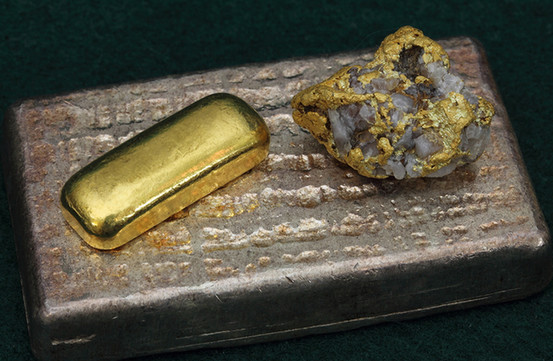
This metal has been a valuable and highly sought-after precious metal for coinage, jewellery, and other arts since long before the beginning of recorded history. Gold standards have sometimes been monetary policies, but were widely supplanted by fiat currency starting in the 1930s. The last gold certificate and gold coin currencies were issued in the U.S. in 1932. In Europe, most countries left the gold standard with the start of World War I in 1914 and, with huge war debts, did not return to gold as a medium of exchange. The value of gold is rooted in its medium rarity, easily handling, easy smelting, non-corrosiveness, distinct colour and non-reactiveness to other elements; qualities most other metals lack.
Because of the softness of pure (24k) gold, it is usually alloyed with base metals for use in jewellery, altering its hardness and ductility, melting point, colour and other properties. Alloys with lower carat rating, typically 22k, 18k, 14k or 10k, contain higher percentages of copper or other base metals or silver or palladium in the alloy. Copper is the most commonly used base metal, yielding a redder colour.
The world consumption of new gold produced is about 50% in jewellery, 40% in investments, and 10% in industry.
Most of the Earth's gold probably lies at its core, the metal's high density having made it sink there in the planet's youth. Virtually all discovered gold is considered to have been deposited later by meteorites that contained the element, with the asteroid that formed Vredefort crater having been implicated in the formation of the largest gold mining region on earth, Witwatersrand basin.
Gold in Jewellery
Because of the softness of pure (24k) gold, it is usually alloyed with base metals for use in jewellery, altering its hardness and ductility, melting point, colour and other properties. Alloys with lower carat rating, typically 22k, 18k, 14k or 10k, contain higher percentages of copper or other base metals or silver or palladium in the alloy. Copper is the most commonly used base metal, yielding a redder colour.
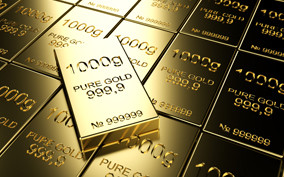
Eighteen-carat gold containing 25% copper is found in antique and Russian jewellery and has a distinct, though not dominant, copper cast, creating rose gold. Fourteen-carat gold-copper alloy is nearly identical in colour to certain bronze alloys, and both may be used to produce police and other badges. Blue gold can be made by alloying with iron and purple gold can be made by alloying with aluminium, although rarely done except in specialized jewellery. Blue gold is more brittle and therefore more difficult to work with when making jewellery.
Fourteen- and eighteen-carat gold alloys with silver alone appear greenish-yellow and are referred to as green gold. White gold alloys can be made with palladium or nickel. White 18-carat gold containing 17.3% nickel, 5.5% zinc and 2.2% copper is silvery in appearance. Nickel is toxic, however, and its release from nickel white gold is controlled by legislation in Europe.
Alternative white gold alloys are available based on palladium, silver and other white metals, but the palladium alloys are more expensive than those using nickel. High-carat white gold alloys are far more resistant to corrosion than are either pure silver or sterling silver.
Silver
Silver is a chemical element with the chemical symbol Ag (Greek: árguros, Latin: argentum, both from the Indo-European root *arg- for "grey" or "shining") and atomic number 47. A soft, white, lustrous transition metal, it possesses the highest electrical conductivity of any element and the highest thermal conductivity of any metal. The metal occurs naturally in its pure, free form (native silver), as an alloy with gold and other metals, and in minerals such as argentite and chloragyrite. Most silver is produced as a byproduct of copper, gold, lead, and zinc refining.
Silver has long been valued as a precious metal, used in currency coins, to make ornaments, jewellery, high-value tableware and utensils (hence the term silverware) and as an investment in the forms of coins and bullion. Silver metal is used industrially in electrical contacts and conductors, in mirrors and in catalysis of chemical reactions. Its compounds are used in photographic film and dilute silver nitrate solutions and other silver compounds are used as disinfectants and microbiocides oligodynamic effect). While many medical antimicrobial uses of silver have been supplanted by antibiotics, further research into clinical potential continues.
Silver metal is used industrially in electrical contacts and conductors, in mirrors and in catalysis of chemical reactions. Its compounds are used in photographic film and dilute silver nitrate solutions and other silver compounds are used as disinfectants and microbiocides oligodynamic effect). While many medical antimicrobial uses of silver have been supplanted by antibiotics, further research into clinical potential continues.
Silver in Jewellery
Jewellery and silverware are traditionally made from sterling silver (standard silver), an alloy of 92.5% silver with 7.5% copper. In the US, only an alloy consisting of at least 90.0% fine silver can be marketed as "silver" (thus frequently stamped 900). Sterling silver (stamped 925) is harder than pure silver, and has a lower melting point (893°C) than either pure silver or pure copper. Britannia silver is an alternative, hallmark-quality standard containing 95.8% silver, often used to make silver tableware and wrought plate. With the addition of germanium, the patented modified alloy Argentium Sterling silver is formed, with improved properties, including resistance to firescale.
Sterling silver jewellery is often plated with a thin coat of .999 fine silver to give the item a shiny finish. This process is called "flashing". Silver jewellery can also be plated with rhodium (for a bright, shiny look) or gold (to produce silver gilt).
Silver is a constituent of almost all coloured carat gold alloys and carat gold solders, giving the alloys paler colour and greater hardness. White 9 carat gold contains 62.5% silver and 37.5% gold, while 22 carat gold contains a minimum of 91.7% gold and 8.3% silver or copper or other metals.
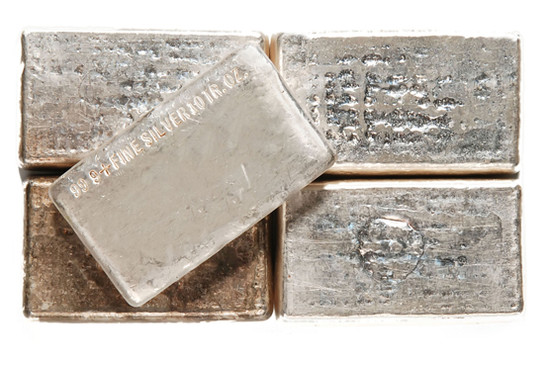
Historically, the training and guild organization of goldsmiths included silversmiths, as well, and the two crafts remain largely overlapping. Unlike blacksmiths, silversmiths do not shape the metal while it is red-hot, but instead, work it at room temperature with gentle and carefully placed hammer blows. The essence of silversmithing is to take a flat piece of metal and to transform it into a useful object using different hammers, stakes and other simple tools.
While silversmiths specialize in, and principally work silver, they also work with other metals, such as gold, copper, steel, and brass. They make jewellery, silverware, armor, vases, and other artistic items. Because silver is such a malleable metal, silversmiths have a large range of choices with how they prefer to work the metal. Historically, silversmiths are mostly referred to as goldsmiths, which was usually the same guild. In the western Canadian silversmith tradition, guilds do not exist; however, mentoring through colleagues becomes a method of professional learning within a community of craftspeople.
Traditionally, silversmiths mostly made "silverware" (cutlery, tableware, bowls, candlesticks and such). Only in more recent times has silversmithing become mainly work in jewellery, as much less solid silver tableware is now handmade.
Platinum
Platinum is a chemical element with the chemical symbol Pt and an atomic number of 78.
Its name is derived from the Spanish term platina, which is literally translated into "little silver".It is a dense, malleable, ductile, precious, gray-white transition metal.
Platinum has six naturally occurring isotopes. It is one of the rarest elements in the Earth's crust and has an average abundance of approximately 5 ?g/kg. It is the least reactive metal. It occurs in some nickel and copper ores along with some native deposits, mostly in South Africa, which accounts for 80% of the world production.
As a member of the platinum group of elements, as well as of the group 10 of the periodic table of elements, platinum is generally non-reactive. It exhibits a remarkable resistance to corrosion, even at high temperatures, and as such is considered a noble metal. As a result, platinum is often found chemically uncombined as native platinum. Because it occurs naturally in the alluvial sands of various rivers, it was first used by pre-Columbian South American natives to produce artifacts. It was referenced in European writings as early as 16th century, but it was not until Antonio de Ulloa published a report on a new metal of Colombian origin in 1748 that it became investigated by scientists.
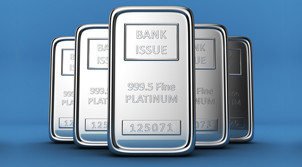
Platinum, along with the rest of the platinum metals, is obtained commercially as a by-product from nickel and copper mining and processing. During electrorefining of copper, noble metals such as silver, gold and the platinum group metals as well as selenium and tellurium settle to the bottom of the cell as "anode mud", which forms the starting point for the extraction of the platinum group metals.
Platinum in Jewellery
Platinum is a precious metal commodity; its bullion has the ISO currency code of XPT. Coins, bars, and ingots are traded or collected. Platinum finds use in jewellery, usually as a 90â95% alloy, due to its inertness and shine. Jewellery trade publications advise jewelers to present minute surface scratches (which they term patina) as a desirable feature.
In watchmaking, Vacheron Constantin, Patek Philippe, Rolex, Breitling, and other companies use platinum for producing their limited edition watch series. Watchmakers appreciate the unique properties of platinum, as it neither tarnishes nor wears out (relative to gold).
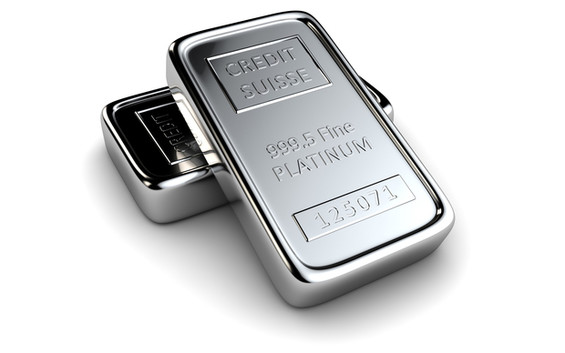
During periods of sustained economic stability and growth, the price of platinum tends to be as much as twice the price of gold, whereas during periods of economic uncertainty, the price of platinum tends to decrease due to reduced industrial demand, falling below the price of gold. Gold prices are more stable in slow economic times, as gold is considered a safe haven and gold demand is not driven by industrial uses. In the 18th century, platinum's rarity made King Louis XV of France declare it the only metal fit for a king.
Palladium
Palladium is a chemical element with the chemical symbol Pd and an atomic number of 46. It is a rare and lustrous silvery-white metal discovered in 1803 by William Hyde Wollaston. He named it after the asteroid Pallas, which was itself named after the epithet of the Greek goddess Athena, acquired by her when she slew Pallas. Palladium, platinum, rhodium, ruthenium, iridium and osmium form a group of elements referred to as the platinum group metals (PGMs). These have similar chemical properties, but palladium has the lowest melting point and is the least dense of them.
Ore deposits of palladium and other PGMs are rare, and the most extensive deposits have been found in the norite belt of the Bushveld Igneous Complex covering the Transvaal Basin in South Africa, the Stillwater Complex in Montana, United States, the Thunder Bay District of Ontario, Canada, and the Norilsk Complex in Russia. Recycling is also a source of palladium, mostly from scrapped catalytic converters. The numerous applications and limited supply sources of palladium result in the metal attracting considerable investment interest.
Palladium in Jewellery
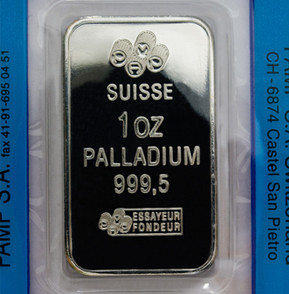
Palladium itself has been used as a precious metal in jewellery since 1939, as an alternative to platinum for making white gold. This use resulted from the naturally white colour of palladium, which required no rhodium plating. Palladium is proportionally much lighter than platinum. Similar to gold, palladium can be beaten into a thin leaf form as thin as 100 nm (1/250,000 in). Unlike platinum, palladium may discolour upon heating to above 400 °C (752 °F); it is relatively brittle and reacts with strong acids such as nitric acid.
Palladium is one of the three most popular metals used to make white gold alloys (nickel and silver can also be used). Palladium-gold is a more expensive alloy than nickel-gold, but seldom causes allergic reactions (though certain cross-allergies with nickel may occur).
When platinum was declared a strategic government resource during World War II, many jewellery bands were made out of palladium. As recently as September 2001, palladium was more expensive than platinum and rarely used in jewellery also due to the technical obstacle of casting. However, the casting problem has been resolved and its use in jewellery has increased because of a large spike in the price of platinum and a drop in the price of palladium.
Rhodium
Rhodium is a chemical element that is a rare, silvery-white, hard, and chemically inert transition metal and a member of the platinum group.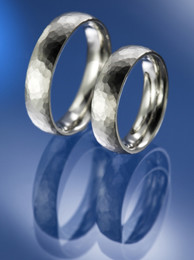 It has the chemical symbol Rh and atomic number 45. It is composed of only one naturally-occurring isotope, 103Rh. Naturally occurring rhodium is usually found as the free metal, alloyed with similar metals, and rarely as a chemical compound in minerals such as bowiete and rhodplumsite. It is one of the rarest and most valuable precious metals.
It has the chemical symbol Rh and atomic number 45. It is composed of only one naturally-occurring isotope, 103Rh. Naturally occurring rhodium is usually found as the free metal, alloyed with similar metals, and rarely as a chemical compound in minerals such as bowiete and rhodplumsite. It is one of the rarest and most valuable precious metals.
Rhodium is a so-called noble metal, resistant to corrosion, found in platinum- or nickel ores together with the other members of the platinum group metals. It was discovered in 1803 by William Hyde Wollaston in one such ore, and named for the rose colour of one of its chlorine compounds, produced after it reacted with the powerful acid mixture aqua regia.
Because rhodium metal is inert against corrosion and most aggressive chemicals, and because of its rarity, rhodium is usually alloyed with platinum or palladium and applied in high-temperature and corrosion-resistive coatings. White gold is often plated with a thin rhodium layer to improve its appearance while sterling silver is often rhodium plated for tarnish resistance.
Rhodium in Jewellery
Rhodium finds use in jewellery and for decorations. It is electroplated on white gold and platinum to give it a reflective white surface. This is known as rhodium flashing in the jewellery business. It may also be used in coating sterling silver to protect against tarnish, which is silver sulfide (Ag2S) produced from the atmospheric hydrogen sulfide (H>2S). Solid (pure) rhodium jewellery is very rare, because the metal has both high melting point and poor malleability (making such jewellery very hard to fabricate) rather than due to its high price. Additionally, its high cost assures that most of its jewellery usage is in the form of tiny amounts of powder (commonly called rhodium sponge) dissolved into electroplating solutions.
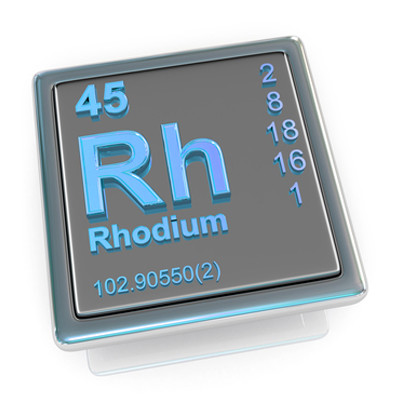
Rhodium has also been used for honors or to symbolize wealth, when more commonly used metals such as silver, gold, or platinum are deemed insufficient.
Sources: http://en.wikipedia.org/wiki
Contact us on:

